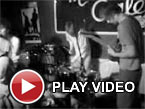Koen Holtkamp, "Motion"
 My general lack of excitement about current glut of synthesizer albums is well-documented, but there are a handful of artists that I still look forward to and Koen Holtkamp is one of them. On this, his first solo album for Thrill Jockey, he delivers yet another fine set of vibrantly burbling analog sounds. While I do not necessarily love every single song on Motion, it certainly contains some of his best work and reaffirms my belief that Koen is in a class of his own when it comes to constructing dynamic, multi-layered synth opuses.
My general lack of excitement about current glut of synthesizer albums is well-documented, but there are a handful of artists that I still look forward to and Koen Holtkamp is one of them. On this, his first solo album for Thrill Jockey, he delivers yet another fine set of vibrantly burbling analog sounds. While I do not necessarily love every single song on Motion, it certainly contains some of his best work and reaffirms my belief that Koen is in a class of his own when it comes to constructing dynamic, multi-layered synth opuses.
This album is a bit of a compositional divergence for Holtkamp, as the first three of these four songs were all composed and recorded in the studio.  While that is generally a very normal way to create an album for many, it is not for Koen, as most of his previous solo work has evolved from his live performances.  Initially, that seemed like a dubious move to me, as one of my favorite parts of Holtkamp's aesthetic has always been the way that his songs can gradually blossom from unpromising beginnings into something quite mesmerizing once all of the accumulating loops are finally in place.  Thankfully, that magic remains mostly intact–the only real change is that the pieces maybe develop a bit faster than they did previously, though they still all feel somewhat epic in scope.  Yet another of Motion's innovations is that working primarily in the studio inspired Koen to augment a few pieces with non-synth textures, most prominently with the distorted electric guitar melody in "Vert."
Astonishingly, I like electric guitars even less than vintage synthesizer textures (I am very picky), so "Vert" is my least favorite song on the album, though it is not bad by any means.  Koen's other instrumental divergence, "Crotales," is much more to my liking, augmenting its burbling, shimmering arpeggios with warm (virtual) stand-up bass and gently twinkling crotales.  The best pieces, however, are the synth-only bookends, "Between Visible Things" and the legitimately epic "Endlessness," which was not composed in the studio.
"Between Visible Things" begins with bright, gently phasing arpeggios over a slowly descending chord progression augmented by sustained electric guitar.  Gradually, however, Koen starts spiraling some sounds out of his previously rigid pattern and a melancholy bass burble appears to pull the cheeriness into darker and more emotionally resonant waters.  Once that happens, the piece is essentially firing on all cylinders and Koen expertly keeps the proceedings compelling by artfully adding and removing layers.  The 21-minute "Endlessness," on the other hand, captures Holtkamp at his long-form, snowballing zenith, evolving from swaying minimal drone into a complexly multi-layered crescendo with a very cool swooping melody.  While it is by far the best piece on Motion, "Endlessness" is basically a reprise of all of the same themes that fill the rest of the album–the sole key difference is that it is just much longer and more slow-burning.
As far as straight-up synthesizer albums go, this is definitely one of the best ones that I have heard in the last few years, but "Endlessness" (which takes up literally half of the album) is actually wonderful enough to make me forget that I am listening to a synth album altogether: sure, the textures still sound like synthesizers, but they feel like a mere tool used to create something of hypnotic, evolving beauty rather than the main attraction.  Though I suppose there is some irony in the fact that the best piece on this album is the sole piece that stuck to Koen's previous methods, the end result is quite possibly the best album of his career, so he is probably nearing the peak of his powers no matter how he chooses to work.
 



